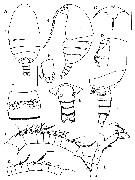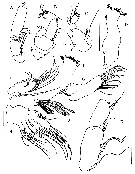|
|
 |
Fiche d'espèce de Copépode |
|
|
Calanoida ( Ordre ) |
|
|
|
Clausocalanoidea ( Superfamille ) |
|
|
|
Scolecitrichidae ( Famille ) |
|
|
|
Paraxantharus ( Genre ) |
|
|
| |
Paraxantharus victorbergeri Markhaseva, 2010 (F) | |
| | | | | | | Ref.: | | | Markhaseva, 2010 (p.270, figs.F) |  issued from : E.L. Markhaseva in Crustaceana, 2010, 83 (3). [p.271, Fig.1]. Female (from 58°15'S, 24°20'W): A-B, habitus (dorsal and lateral, respectively); C, rostrum (ventral); D, forehead (lateral); E, posterior prosome and urosome (dorsal); F, same (lateral); G, genital double-somite; (ventral); H, left caudal ramus (ventral); J, A1: segments I-XI (8th); K, A1: segments XII (9th) to XX (17th); L, A1: segments XXI (18th) to XXVIII (24th). Scale bars 0.1 mm. Nota : Prosome 3.1 times as long as urosome. Rostrum a bifurcate plate with filaments. A1 24-segmented, shorter than prosome, reacihing posterior part of pediger 3 Cephalosome and pedigerous somite 1 fused, 4th and 5th separate ; Posterior corners triangular in dorsal view and rounded in lateral view ; Caudal rami with 4 terminal setae, 1 small dorsal seta, a small ventral seta, and a vestigial lateral seta.
|
 issued from : E.L. Markhaseva in Crustaceana, 2010, 83 (3). [p.272, Fig.2]. Female: A, A2 (exopod); B, A2 (coxa, basis, proximal exopodal segment, and endopod); C, Md (palp); D, Md (gnathobase); E, Md (cutting edge); F, Mx1 (coxal and basal endites, endopod, and exopod); G, Mx1 (praecoxal arthrite and coxal epipodite); H, Mx2 (endopod setae partly figured); J, Mx2 (endopod); K, Mxp (syncoxa and basis). Scale bars 0.1 mm. Nota : Mx1 : praecoxal endite with 9 terminal and 4 posterior setae, and 1 anterior seta ; coxal endite with 2 setae, coxal epipodite with 9 setae ; proximal basal endite with 3 setae, distal basal endite with 4 setae ; endopod with 11 setae ; exopod with 8 setae. Mx2 : proximal praecoxal endite with 5 setae, distal with 3 setae ; proximal and distal coxal endites with 3 setae each ; proximal basal endite with 4 setae, one of these thicker than the others ; endopod with 9 setae : 3 sensory worm-like, 5 sensory brush-like (3 thicker) and 1 sclerotized seta. Mxp : syncoxa with 1 long seta on proximal praecoxal endite, 2 setae on middle endite (1 short, sclerotized seta and 1 long, poorly scerotized, worm-like sensory seta), and 3 setae on distal praecoxal endite (2 short setae and 1 long, poorly sclerotized, worm-like sensory seta) ; coxal endite with 3 setae ; basis with 3 medial and 2 distal setae, and a row of denticles ; endopod 5-segmented, setal formula 4, 4, 3, 3+1, and 4 setae. Rem.: The species differs P. brittae in 1- Md gnathobase with 4 oblique teeth (vs. no oblique teeth in P. brittae; 2- basal and proximal endites of Mx1 with 3 and 4 setae, respectively (vs. 4 and 5 setae in P. brittae) and exopod with 8 setae (9 in P. brittae); 3- 2 of 5 brush-like sensory setae of endopod of Mx2 thinner (vs. all 5 brush-like setae identical in P. brittae); 4- sensory seta of distal praecoxal endite of syncoxa of Mxp is poorly sclerotized and worm-like (vs. brush-like in P. brittae); 5- basis of Mxp provided with spinules (vs. spinules absent in P. brittae.
|
 issued from : E.L. Markhaseva in Crustaceana, 2010, 83 (3). [p.273, Fig.3]. Female: A, Mxp (endopod); B, P1; C, P2; D, P3 (two distal exopodal segments broken off); E, P4 (two distal endopod segments broken off); F, P5 (anterior); G, P5 (posterior). Scale bars 0.1 mm.
| | | | | NZ: | 1 | | |
|
Carte de distribution de Paraxantharus victorbergeri par zones géographiques
|
| | | | | | | Loc: | | | Antarct. (58°15'S, 24°20'W) | | | | N: | 1 | | | | Lg.: | | | (1048) F: 1,56; {F: 1,56} | | | | Rem.: | above the sea bed (3931-3925 m) | | | Dernière mise à jour : 28/01/2015 | |
|
|
 Toute utilisation de ce site pour une publication sera mentionnée avec la référence suivante : Toute utilisation de ce site pour une publication sera mentionnée avec la référence suivante :
Razouls C., Desreumaux N., Kouwenberg J. et de Bovée F., 2005-2026. - Biodiversité des Copépodes planctoniques marins (morphologie, répartition géographique et données biologiques). Sorbonne Université, CNRS. Disponible sur http://copepodes.obs-banyuls.fr [Accédé le 07 janvier 2026] © copyright 2005-2026 Sorbonne Université, CNRS
|
|
 |
 |






